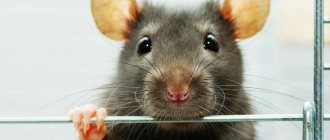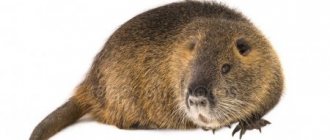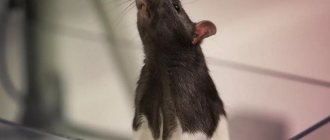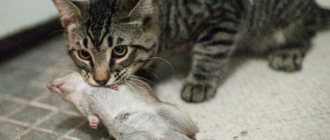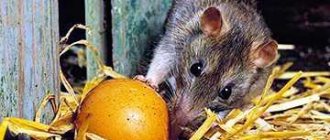Rats' habitat is vast
Rats thrive in most environments where food and shelter are available. Norway rats can be found in homes, warehouses, office buildings, sheds, basements, sewers, landfills and other places that provide ample food. They dig holes in the ground for shelter, nesting and food storage. Burrows usually start next to buildings, fences, or other cover. Black rats do not usually dig burrows; they are found above ground level: in trees, rocks, attics, upper levels of warehouses, wall cavities and roofs.
What is important to know about the “gray enemy”
If you have never encountered rats before, you have no idea what kind of cunning animal you want to declare war on. First of all, remember - these small unpleasant rodents have intelligence. Scientists from Oxford have found that rats are characterized by abstract thinking.
As you develop methods to catch a rat in your home, accept that the struggle will not be easy. If at least one animal falls into the traps you set, then other individuals will analyze the death and will no longer stick their nose into the trap. A similar situation will happen with poison. The deceased relative will clearly demonstrate to the rodents what substances caused death. Therefore, in the future, rats with a sensitive sense of smell will accurately guess the poison by smell and will not touch it.
Intelligence, lifestyle, food
Insidious and dangerous rats can be found in any outbuildings or garages. They often climb into private houses and, having found food for themselves, quickly develop new territories. Sometimes rodents can be found even in city apartments. Who are they - long-tailed pests that have intelligence and bring destructive disasters. The following facts are known.
- Lifespan. Individuals living in landfills and garbage can live up to one and a half years. And rats live up to about two or three years in the warm and comfortable conditions of an apartment or house.
- External data. A rat may have gray or black fur. It has two pairs of paws, with the hind ones being much stronger than the front ones. The body length of an adult varies between 14-25 cm. The tail can reach 18-20 cm. Weight is approximately 200-400 g.
- Upper incisors. Throughout the rat's life cycle, its upper teeth grow. And quite intensively (1 cm per month). Therefore, the rodent needs to constantly grind its incisors. Otherwise, the teeth grow into the jaw, and the rat dies an extremely painful death. To avoid this, she has to constantly gnaw on all objects that come in her way.
- Mobility. The rat is very active. It is capable of reaching speeds of up to 10 km/h. And if necessary, it takes a barrier 80-100 cm high. Rodents are able to swim and dive. They can stay in water for about 12 hours.
- Nutrition . In nature, wild individuals feed on fish, shellfish, mice, and frogs. Rats enjoy eating grain and plant seeds. If rodents settle near humans, their diet consists of grains, cereals, food waste and products. And if there is a period of famine, then cannibalism can flourish in the colonies - rats eat their relatives.
- Assault on a person. Can a rat attack a person? In most cases, rodents emerge from their burrows at night, when the owners are already resting. This lifestyle is associated with a reluctance to catch a person’s eye. But in some situations, rats can become quite aggressive. The attack is usually dictated by the following events: the rodent has rabies, is afraid, is driven out of its inhabited areas, and is experiencing severe hunger.
- Reproduction. In the wild, rodents give birth twice a year. But those individuals that live in warm conditions receive sufficient nutrition and are able to reproduce up to eight times a year, bringing from two to 20 cubs at a time. Puberty in rat pups occurs at three to four months.
Danger to humans
Meeting a rat causes fear in many people. What can be frightening in an animal trying to hide from human eyes? Musophobia (fear of rats), according to psychics, is inherent in humans at the genetic level, dating back to the times when tailed pests served as a source of infection with fatal diseases. However, such fear is still quite justified today. Rats can cause serious harm.
Mad rats are especially dangerous. The disease affects the nervous system of the rodent, so it becomes very aggressive. Such individuals attack a person even if the latter does not touch them.
Rats can squeeze through anywhere
A rat can squeeze through a hole the size of a quarter thanks to its collapsible skeleton. Its ribs are hinged to its spine and can fold up like an umbrella, meaning that any opening large enough for a rat's head is large enough for the rest of its body.
Photo: www, pestologyltd.co.uk
Rats can even chew their way through thick wood, metal pipes, brick walls and cement. Their front teeth are long - they grow about 12-13 cm per year - and also very sharp. To keep their teeth from becoming too long, rats must constantly chew on hard objects and sharpen the edges of their upper and lower teeth against each other, like a knife on a whetstone. The teeth will eventually grow into the brain if rats stop sharpening them.
External differences
The main signs of differences between rats and mice can be observed in external characteristics. First of all, they are clearly visible in the mass of animals, as well as in the structure of the body. Based on them, you can easily determine which representative of the rodent family is in front of you.
Dimensions
The most significant difference between rodents is determined by size. Rats have significantly larger dimensions and a stocky body. The length of an adult can reach 30 cm, not counting the tail. At the same time, weight indicators fluctuate between 600–700 g. A mouse is a smaller rodent. It rarely grows more than 10 cm in length, and its weight does not exceed 30 g.
Tail
It is also not difficult to distinguish animals by the characteristics of the tail. In rats, it looks more massive, thick, has an impressive length, which is sometimes not inferior to the length of the main body, and sometimes exceeds it, reaching up to 35 cm. The tail is bald or bristly, depending on the species. In small rodents, the length of the tail ranges from 4 to 6 cm, almost all over it is covered with small hairs.
Find out also what to feed and how to care for a decorative rat.
Head
The shape of the head of a rat and a mouse also has significant differences. The former has a more elongated, pointed muzzle. The organs of vision are poorly developed. Small black or red eyes are deep-set and have a small viewing angle, so the animals have to constantly turn their heads to examine their surroundings. It is interesting that they see it in gray tones, and red objects are transformed into black.
In mice, the shape of the head is more rounded, flattened, and its size is much smaller. But the eyes, compared to the size of the muzzle, are large, convex, and expressive. The animal has developed farsightedness.
Important! Both types of rodents have teeth that grow throughout their lives, so they need to be given hard objects to chew on that can grind down their incisors.
Paws
There are practically no calluses on the rat's paws, which are necessary for climbing. But there are movable fingers with sharp claws. Thanks to this property, rodents can move freely through trees. Sometimes they make homes for themselves in abandoned hollows. The excellent muscularity of the paws allows rodents to jump long distances. Another advantage of the limbs is the presence of membranes between the fingers, which are similar in appearance to folds of skin.
They make rats excellent swimmers, capable of obtaining food in a body of water. When moving along a horizontal surface, the paws of rodents are widely spread. If you manage to examine the footprint, you will notice that the angle between the outer phalanges is about 180°. Since the predator often moves by jumping, the distance between the tracks can also be impressive.
You may find it useful to know what types of domestic rodents there are.
The legs of mice are short. Each of them has 5 tenacious fingers, so these small rodents are able to move through trees. However, their limbs are not as powerful as those of rats. They move mainly in mincing steps, with the toes spread minimally, and the distance between the tracks is about 1 cm.
Wool
Mice have softer, more delicate fur. In nature, its predominant color is brownish-gray or ash-gray, but it can vary depending on the environment. For example, desert mice have a yellow-sandy coat color, and among decorative species there are white, black, gray-blue, and variegated tones.
Did you know? Mice keep their homes clean and tidy, and with droppings they mark routes to food sources.
Rats have thicker, longer, and coarser fur. The most common colors are gray and dark brown. In individuals bred as decorative domesticated animals, many other shades are found: white, gray, reddish, spotted, etc.
Ears
The rat's ears are straight, even, pointed towards the top.] Hearing is very well developed - the animal perceives sounds with a frequency of up to 40 kHz, while humans - up to 20 kHz. In mice, this figure is even higher - animals perceive sounds with a frequency of up to 100 kHz, although the hearing organs themselves are small, rounded, rolled up.
Rats are excellent athletes
The long claws on a rat's paws allow the rodent to scale brick or cement walls with the ease of Spider-Man. Getting down is also not a problem: a rat can fall from a height of 15 meters and land on its paws without injury. They are also phenomenal jumpers: rats can jump up to 60 cm in height from a standing position. According to one study, rats can lift objects that weigh almost 0.5 kg - more than the average body weight of a rodent.
Rats are able to stay in water for three days in a row (in laboratory conditions) and hold their breath under water for up to three minutes. This means they can swim through sewer pipes, squeeze through water pipes, and lick through a hole in a toilet. There are species that can swim more than 1.6 km without resting!
Curious facts about rats
Rats are unique mammals. April 4 is celebrated annually as International Rat Day . Of course, this applies to domestic mammals, which are the favorites of their owners.
There are also “rat tournaments” . They have been held for 30 years , and in 2001 the First Olympics . Participants competed in rock climbing, tightrope walking, long jump, running, and tightrope walking. The winner was awarded a bag of oats and a two-week reprieve from the experiment.
Rats size XXL
On average, a rat is about 40 cm long (including the tail) and weighs 450 grams. If a rat lives near a permanent food source, such as a trash can, it can grow up to 50 cm in length and weigh 0.9 kg. But this is insignificant compared to the Bosavi woolly rat, which was discovered in 2009 by a BBC expedition on the territory of an extinct volcano in Papua New Guinea. The animal was 81 cm long (including the tail) weighed more than 1.36 kg and showed no fear of people. It is believed to be one of the largest rats in the world. However, don't be afraid to meet it on the street: the rat, which scientists believe belongs to the genus Mallomys, lives only in the area of the volcano.
Photo: www.animals.fandom.com
Unfortunately, scientific research has shown that regular rats are getting larger. On the other hand, researchers believe that physiology will not allow them to turn into giant rats. They will most likely never exceed 1 kg.
Clairvoyants
Everyone reads facts about rats with great interest; many people know about the sixth sense of these animals.
Rats are the first to leave a ship before it dies, regardless of the cause of the collapse - a natural disaster, shelling. In wartime, during the bombing period, people hid where the rodents fled. The animals leave the house together before a huge fire and never return to their previous places. Even after several years, when the smell of burning is no longer audible.
Rats do not live at testing grounds where various weapons are tested. During the war, soldiers noticed strange behavior of rodents before shelling. The day before, everyone disappeared somewhere in an unknown direction.
Interesting!
In the last century, France experienced a massive migration of rats. A huge clothing market was closing and moving to a new location. The rodents gathered together in a colony and left. And not just in an unknown direction, but precisely to where a place has been prepared for a new market.
They have very sensitive taste buds
Poisoning a rat is not easy. Animals can detect infinitesimal amounts of poison in food—as little as one part in a million. It's like finding a teaspoon of cocoa in 5,909 liters of milk. Rats are also wary when eating unfamiliar food; they start by tasting a tiny piece of food to make sure that the food is harmless.
Sometimes rats bite sleeping people on the face and hands at night, attracted by food debris on human skin. Once a rat bites a person, the chances of it biting people again increases. It's like finding a new favorite dish and ordering it at every restaurant you visit.
Rodents are cannibals
Rats and mice eating each other are not fiction. This is practiced in every family of rodents. The female eats weak cubs, leaving only strong offspring alive. If a male gets into the nest, he calmly eats his own.
Interesting!
There was one effective method in the naval army. 5 rats were thrown into a metal barrel. They were starving. They began to eat each other, the strongest survived. But this was already a cannibal beast, which, when released, hunted for its relatives.
Rats eat each other when there is a lack of food, or if a stranger wanders into the pack. In other situations, animals show humanity to each other, even trying to take a wounded relative with them. Eating is common, but not natural.
Interesting!
An eyewitness described the story on the forum. He hit me in the barn and left me to die. He returned a few hours later and saw an interesting picture - several rats were trying to drag her away with them.
The rat has an incredible sense of smell
They have a hypersensitive nose and are especially sensitive to unpleasant odors, which can cause respiratory distress. These small rodents have a nose with 1,207 olfactory receptor genes. They come just behind elephants (1,948 genes) but are far ahead of humans (396 genes) and dogs (811 genes).
Photo: Oxana Kuznetsova
This is likely due to the fact that rats have evolved a sense of smell to be able to sniff out hidden food sources. Rat Nose is so good that it helped clear landmines from Mozambique, and they are now clearing landmines in Cambodia, Zimbabwe and Angola. The rats themselves are too small to detonate the mines, so they are completely safe. The rats simply point out where the explosives are buried so that the mine can be safely detonated.
Amazing and incredible
There are many stories about the amazing abilities of these rodents. For example, one of the most famous says that rats created a real living ladder in order to reach the contents of a deep container - vegetable oil, and successfully achieved what they wanted. Interesting and reliable facts about rats were discovered during scientific research:
- The learning ability of rats is extremely high, and this applies to both ordinary and decorative animals. They easily learn to climb a ladder and drag it behind them in order to climb even higher. To do this, just place the treat at the very top;
- Rats can master the most intricate labyrinths in just a few “reconnaissance” runs. Even if after some time the animal becomes blind, deaf, or incapable of touch, such an acquired skill is not lost;
- Rodents are able to navigate drawn figures, determining their shape and approximate value. If identification of a figure promises a desired treat, the rat performs all the required actions for this. The animal cannot be confused even when the size of the picture changes or it is included in a different context.
Such experiments and their results clearly demonstrate the unique intelligence of rats as a biological species.
Rats are very sociable
In the wild, rats tend to live in groups of five, often living in close proximity to other rat families. In areas of low density there is one male per group, which is highly territorial. He is the only mating partner for females. In areas of higher density, males tend to be less territorial, and there may be several males in a group.
These rodents also love human company and may respond to their name. Rats are easy to train. Just like dogs, they will do anything for a tasty treat. They enjoy the interaction they get from doing things like searching, jumping, and coming when called.
Fact 3: They talk to each other
Moreover, their vocabulary is very diverse. They communicate with each other through various sounds, each of which has its own meaning. That is why in the rat community the connection between individuals is so well established: they communicate, negotiate, share impressions, almost like people. But such conversations are inaccessible to human ears, since the frequency range of these sounds is different from ours.
What else gray pests have in common with people is the fear of tickling. Like us, rodents have sensitive points on their bodies, when you tickle them you can hear a real rat laugh.
The rats laugh, but we don't hear it
Rats make high-pitched chirping sounds (especially when tickled), but humans cannot hear them. Rats communicate at a very high frequency, above 50 kilohertz, so we unfortunately cannot hear their laughter without the help of a bat detection device. Rats especially love to be tickled on the back of their heads. When happy, they chatter or grind their teeth, accompanied by eye twitching. But they will stop laughing when conditions change, such as a bright light or the smell of an approaching cat. Research shows that primates such as bonobos and chimpanzees, dogs and dolphins can also laugh.
Heightened sensitivity that replaces vision
Rats are not completely blind, but they do not see very well. These pets are color blind. All objects are spots of different sizes for them. They perceive people and animals as fuzzy large moving objects. But this does not prevent them from being perfectly oriented in space. Rodents receive all the necessary information about the world around them thanks to their unusually acute sense of smell and hearing.
Rats have a so-called sixth sense. It is a kind of internal vision for pets, which allows them to anticipate unfavorable events. Anticipating this or that disaster, animals try to run away as quickly as possible in order to hide in a secluded place.
In Novosibirsk there is a monument to laboratory rats and mice
Photo: Irina Gelbukh / Wikimedi
The monument, 1.82 meters high, is located in the courtyard of the Institute of Cytology and Genetics in Novosibirsk. A bronze rodent knitting a DNA double helix, with a small pince-nez on its nose, is installed in memory of the rodents used in laboratory tests. Between 85 and 95% of animals used in laboratories are rodents, including rats, mice, hamsters and gerbils. In the United States alone, 100 million rodents are tested annually.
House mouse – Mus musculus
House mouse
Body length is 6.5-9.5 cm. It can be either a brownish-gray or a completely black mouse. The ears are round in shape. The tail is covered with sparse, short hairs, under which scales are arranged in a ring. The tail reaches half the length of the mouse's body. Lives everywhere except Antarctica and the Far North. They can live both in natural conditions and where people live. Accordingly, if a domestic mouse lives in a house, then it feeds on leftover food, cereals, and in natural conditions it can be grain crops, plant foods, and insects. The house mouse is very prolific. At home, it reproduces all year round, and in nature in the warm season. Pregnancy lasts 19-21 days. There are up to 14 litters per year, up to 12 cubs in each. A characteristic feature that sets the house mouse apart from other types of mice is its muscoid odor, which can smell like urine or sweat. They acquired this smell due to the fact that mice mark their territory. On their paws there are sweat glands that emit a specific odor. These rodents are bred as live food for reptiles, spiders and birds. The mouse is also a laboratory model in laboratory research. House mouse
Rats are known carriers of disease.
They were involved in the spread of about 40 diseases: bubonic plague, typhus, leptospirosis, hemorrhagic fever, salmonella, tapeworm, etc. There are many ways that people or pets can contract the above diseases from rats: rodent bites/scratches, ingestion of contaminated food or water, inhalation of contaminated dust, direct contact with an infected rodent, and bites from infected fleas or ticks.
For many years, rats with plague-infected fleas were thought to have caused the Black Death (1347–1351). The pandemic has killed about 25 million people in Europe, almost a third of the European population. However, recent research suggests that another rodent is to blame for the Black Death: gerbils. The wet conditions of the time caused gerbils, not rats, to flourish. In addition, the distemper virus can be carried by a variety of animals, including cats, dogs, camels, sheep, goats, chipmunks and squirrels. In fact, more than 200 animals are considered carriers of bubonic plague.
Shrews – Soricidae
The shrew mouse has a body from 30 to 50 mm, brownish-gray in color. The muzzle is elongated, with a long, sharp nose. The eyes are small. Legs are short. The tail may be short or long, depending on the species. Distributed everywhere except in the polar regions. They prefer a humid environment. They dig holes or hide near stumps, less often in human dwellings. The mouse hole is paved in the middle with soft grass and dry leaves. Shrews feed on insects and their larvae; they can also eat small lizards, frogs, and the young of other rodents. Reproduction occurs 1-3 times a year. Each litter contains 4-14 cubs. A pregnant mouse carries its young for 13-28 days. The life expectancy of shrews reaches 18 months.
Shrews – Sorex
Shrew
Shrews are a genus of rodents that belong to the shrew family. These are fairly small mice, about 7 cm, gray or brownish in color. They have an elongated, cone-shaped head and a long, pointed nose. The tail is no longer than half the body. They feed on insects, earthworms, arachnids, and small amphibians. They can also eat plant foods. Shrews live in the forests of Asia, Europe (Italian, Spanish, French regions) and North America. They build nests in other people's holes and old stumps. The mouse hole is lined with moss, leaves and twigs. Reproduction occurs in late spring. During the warm period they give 2-3 litters, 7-8 cubs each. Shrews dig the ground in search of food and to build burrows, which contributes to the penetration of oxygen into the soil and the natural regeneration of plantings.
They have incredible fertility
When it comes to reproduction, rats leave rabbits far behind. When they are not eating, they usually mate. During one six-hour receptive period, a female rat can mate up to 500 times, which helps explain how a pair of rats can eventually produce 15,000 offspring in one year and why they are the most widespread mammal in the world.
Photo: www.squeaksandnibbles.com
Rats reach reproductive age five weeks after birth, and continue to reproduce until about two years of age. Gestation usually lasts about three weeks, and litter sizes range from 6 to 20 pups. Peak reproduction occurs in spring and autumn.
Physical and mental abilities of rats
Mammals of the mouse family are able to move along vertical surfaces. They swim excellently at distances reaching about 800 m , while still managing to catch fry.
Individuals reproduce incredibly quickly. The offspring of one female can be 15,000 pups . Despite the extermination of pests, these figures are very impressive.
Once upon a time, nuclear weapons were tested on an American island. Scientists have been waiting for the outcome of the consequences for a long time. For this purpose, traps were set on one of the surviving islands.
To their surprise, the traps were filled with rats, and in large numbers. Biologists realized that rodents are resistant to radiation , and their life cycle has increased. Although scientists have established the lifespan of animals, it is a little more than 1 year .
Pests are naturally endowed with excellent memory . If they find that a set trap or an ordinary stone is slightly moved, then this place will be used by them for 2-3 days.
Rodents are dangerous not only to property, but also to human life . They are carriers of more than 20 pathogens of various diseases. The most common is plague . People have come up with ways to get rid of the disease, but you should not relax your attention, since other dangers can be expected from gray creatures.
Rats are unique animals . They easily distinguish poisoned foods, which indicates excellent mental abilities.
In China, rats are highly valued.
Rats are considered smart and quick-witted animals, capable of surviving everything that life throws at them - be it earthquakes, famine or war. According to Chinese zodiac legend, when the Jade Emperor invited the animals to a feast, the Rat mounted the Ox and jumped off as soon as they arrived, finishing first. Rats are also considered wealth animals and are revered as symbols of fertility in China. The ancient Egyptians and Mayans also worshiped rats. And people born in the year of the Rat are traditionally considered cunning, witty and wealthy.
Increased endurance
Pets have the necessary arsenal of abilities, which allows them to get out of any, even the most difficult situation. Rats are excellent swimmers. They can cover long distances in water and are able to swim to the other side of the river. Rodents run very fast and jump high. A rat can jump to a height of about two meters. In addition, these pets easily distinguish odors and can determine the source of their origin, which makes it easier for them to find food. Thanks to their good memory, they can find a way out of any room or building. Rats feel great at any air temperature. They tolerate both heat and cold well. All these skills allow them to adapt and get used to any conditions, and also increase their survival.
We also recommend reading:
The largest dog breeds What is domestication in animal husbandry Why you should get a cat: reasons voiced by scientists Euthanasia of animals
Did you know?
- All rats belong to the genus Rattus, which includes 51 species.
- Rats don't sweat. They only have sweat glands on the skin of their paws, which are not sufficient for cooling. To regulate their body temperature, they constrict or dilate the blood vessels in their hairless tails.
- The lifespan of a rat depends on whether it is a wild animal or a domestic animal. Rats kept in captivity can live up to 4 years. In the wild, they typically live 2-3 years. They are hunted by owls, hawks, snakes, dogs, cats and other predators.
- Rats have very poor eyesight. They also suffer from color blindness.
- A rat can go without water longer than a camel. Surprisingly, the kangaroo rat (genus Dipodomys) can spend its entire life in the desert without drinking water. It receives most of the moisture it needs from seeds.
- A rat's heart beats 650 times a minute!
- Cedar and pine oils are toxic to rats and should not be used as bedding.
- Rats were among the first animal astronauts. In 1961, France launched a rocket into space with a rat on board.
- Rats are clean people. Rodents, so often associated with sewers and garbage cans, are actually very clean animals. They spend several hours a day cleaning.
- The Dumbo Rat is a fancy rat with large, round ears that give it a cute teddy bear appearance, making it a very popular pet.
Fact 5: about life and about illnesses
It is believed that if a rat bites you, then that’s it, you will get sick with almost the most terrible diseases. In fact, this is more myth than truth. Or rather, even the memory of the plague epidemics that developed from the invasion of rats and claimed thousands of human lives in medieval Europe. Of course, this was a historical fact. And the point here, first of all, is not a rat bite, but the general unsanitary conditions that reigned in the cities of those years. Sewage flowed straight through the streets, food and other waste rotted everywhere, people did not wash for weeks. Under such conditions, the emergence of epidemics is not surprising.
But rat immunity is amazing. These clean animals practically do not get sick. The reason for this is, firstly, a passion for personal hygiene, and secondly, initially good health. Rodents even have a gene that protects them from contracting sexually transmitted diseases.
Rats don't like to bite. For it to bite a person (especially if it is a tamed animal), you need to try very hard. Rodents are peaceful and do not enter into conflicts. And yet, the bitten person may panic: what if I was unlucky and some terrible disease was nevertheless transmitted? There is no need to be scared; usually everything works out. But still, there is a possibility of contracting rabies, especially in the case of a wild animal. Therefore, answering the question of what to do if you are bitten by a rat, we advise you to immediately consult a doctor.
Now about how long they live. Let us warn you right away: if you have such a friend living with you, new emotions and admiration are guaranteed, but not for long. The entire life of an animal is no more than 2-3 years, although some record holders live up to 7-8. That's how long rats live, and it's sad, because, having barely become attached to the pet, the owner is already forced to say goodbye to them.
Now you know all the most interesting things about rats. By keeping these animals in your home and listening to the sounds they make, you will learn to understand how pets communicate and distinguish their intonations. It's always interesting to watch something like this. If you are deciding which is better to get - a rat or a mouse, we recommend the first option. This species is social, gets used to it faster and is easier to learn. In addition, cases of aggression towards humans are more common in mice. Pet stores also sell everything for rats and other rodents.
Presence of musical preferences
Rats don't like all sounds. Rodents even know a little about music. Scientists conducted an experiment. The rats were given several songs to listen to: Mozart, modern music, and the noise of a running fan. Then the animals were placed in a cage with special buttons, pressing each of which made it possible to hear a particular music or sound. Most of the rats chose Mozart. Only a few of them preferred modern music. Nobody liked the sound of the fan running. None of the rodents made their choice in favor of him.




